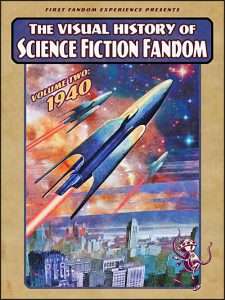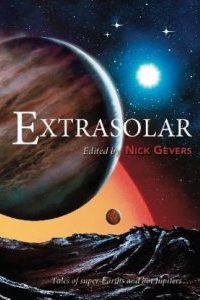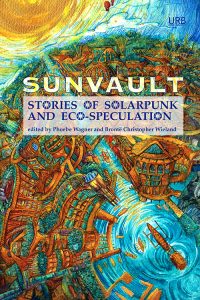Gary K. Wolfe Reviews The Visual History of Science Fiction Fandom – Volume Two: 1940 by David Ritter & Daniel Ritter
 The Visual History of Science Fiction Fandom – Volume Two: 1940, David Ritter & Daniel Ritter (First Fandom Experience 978-1-7366596-1-8, $195.00, 484pp, hc) December 2021.
The Visual History of Science Fiction Fandom – Volume Two: 1940, David Ritter & Daniel Ritter (First Fandom Experience 978-1-7366596-1-8, $195.00, 484pp, hc) December 2021.
It’s already been a couple of years since David & Daniel Ritter’s The Visual History of Science Fiction Fandom, Volume One: The 1930s gave us a sort of tomb-raider’s view of the early days of fan culture, more or less concluding with the first Worldcon in 1939. Since the second Worldcon would be held in Chicago in 1940, it’s not surprising that this becomes the focus of the Ritters’ next volume, The Visual History of Science Fiction Fandom – Volume Two: 1940. But it is a bit of a surprise, since their original book covered a full decade, that this one confines itself to a single year. Had fandom really grown so prolific in the year following that first Worldcon? As the editors note in their introduction, the original plan was to cover 1940 through the 1946 Los Angeles Worldcon, but eventually, because of the sheer mass of material, they had to whittle that down to 1940-1941, and then again to just 1940. It seems they had no problem finding plenty of material, although, as in the earlier volume, some of it serves mostly as odd curiosities, such as Wilson Tucker’s draft card, a rent receipt from the Futurians’ “ivory tower” group home, or pages of illustrations from the work of now-forgotten fan artists. Except for a few pages of original comics and illustrations, including an epic effort by fans to make it to the Worldcon by hopping freight trains from Denver and a strip by Antonio Santis recreating a Chicon room party, virtually all of the documents are originals from various collections, reproduced meticulously in color, so that we can fully appreciate the amateurish hand-lettering and weird choice of pastel paper stock that early fans seemed to favor.
Not surprisingly, much of the volume focuses on the 1940 Worldcon, which did seem to intro labels like “Chicon” (we’re up to Chicon 8 this year), the masquerade, the con suite, the practice of filking (though it wouldn’t get that name for a few years yet). An entire section is devoted to the elaborate efforts of fans – mostly young and with limited funds – to even get to Chicago. But as with the earlier volume, much of the most interesting material consists of sidebars to the main narrative: a futile campaign against “anti-science” attitudes in mad scientist movies and pulps, the “fans are Slans” movement, a debate about the supposed superiority of real fans over mere “readers,” Asimov learning to contend with Campbell’s racism, short but fascinating portraits of pulp editor Mary Gnaedinger and an all-female fanzine called STF-ETTE, distributed at Chicon and including early work by Leigh Brackett.
There are also notes on regional SF groups beginning to form throughout the US, on the early days of Australian fandom, and – most ominously – the near-collapse of fandom in Britain, already suffering the Blitz (apparently Ted Carnell’s effort to introduce New Worlds in 1940 was one of the casualties, although he finally succeeded after the war). Of course, the history of SF isn’t entirely congruent with the history of fandom, and few of the names here will be recognized by contemporary readers. Still, the Ritters’ meticulous research and careful curation serve as reminders that communities have always been crucial to many readers, even when those communities were smaller, far more homogeneous, and at times almost comically more hapless – if no less contentious–than they are today.
Gary K. Wolfe is Emeritus Professor of Humanities at Roosevelt University and a reviewer for Locus magazine since 1991. His reviews have been collected in Soundings (BSFA Award 2006; Hugo nominee), Bearings (Hugo nominee 2011), and Sightings (2011), and his Evaporating Genres: Essays on Fantastic Literature (Wesleyan) received the Locus Award in 2012. Earlier books include The Known and the Unknown: The Iconography of Science Fiction (Eaton Award, 1981), Harlan Ellison: The Edge of Forever (with Ellen Weil, 2002), and David Lindsay (1982). For the Library of America, he edited American Science Fiction: Nine Classic Novels of the 1950s in 2012, with a similar set for the 1960s forthcoming. He has received the Pilgrim Award from the Science Fiction Research Association, the Distinguished Scholarship Award from the International Association for the Fantastic in the Arts, and a Special World Fantasy Award for criticism. His 24-lecture series How Great Science Fiction Works appeared from The Great Courses in 2016. He has received six Hugo nominations, two for his reviews collections and four for The Coode Street Podcast, which he has co-hosted with Jonathan Strahan for more than 300 episodes. He lives in Chicago.
This review and more like it in the April 2022 issue of Locus.
 While you are here, please take a moment to support Locus with a one-time or recurring donation. We rely on reader donations to keep the magazine and site going, and would like to keep the site paywall free, but WE NEED YOUR FINANCIAL SUPPORT to continue quality coverage of the science fiction and fantasy field.
While you are here, please take a moment to support Locus with a one-time or recurring donation. We rely on reader donations to keep the magazine and site going, and would like to keep the site paywall free, but WE NEED YOUR FINANCIAL SUPPORT to continue quality coverage of the science fiction and fantasy field.
©Locus Magazine. Copyrighted material may not be republished without permission of LSFF.






